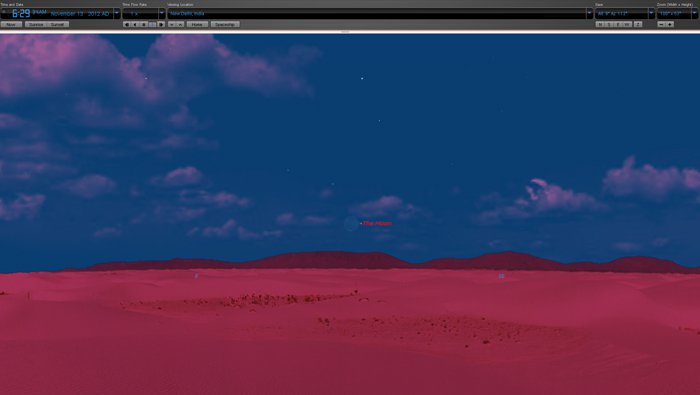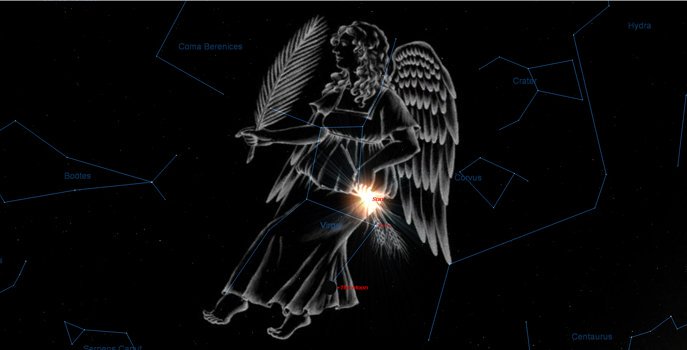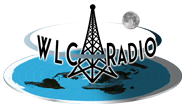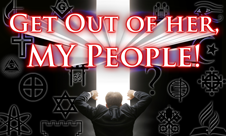Problems with Other Reckoning Methods
Problems with Using Other Conjunction Methods
The Same Day as Conjunction
Some lunar Sabbatarians advocate observing the very day that conjunction takes place as New Moon Day, as opposed to the first day after conjunction. The problem with this method is that the new month is begun before the old month is finished. The lunation (month) is not truly over until the moon enters conjunction with the sun, after which it will again become illuminated as it begins a new revolution. The reason for making the day after conjunction New Moon Day, as opposed to the actual day that conjunction takes place, is because a day cannot simultaneously be part of the old month and part of the new month. Therefore, the first dawn after conjunction takes place is the beginning of the new month.
The Day After Conjunction - Provided the First Visible Crescent is Seen that Evening
Some lunar Sabbatarians teach that New Moon Day is the day after Conjunction, provided the first visible crescent is sighted that evening. This, they say, is because the first visible crescent is the signal to begin the workweek. This method requires that the day after the last Sabbath on the 29th always be observed as a New Moon Day. If the first visible crescent moon is seen on that evening, then that day was New Moon Day. If the first visible crescent is not seen, then that day was the 30th and the following day will be New Moon Day. There are two insurmountable issues with employing this method:
- Using this method, it is impossible to consistently unite the world in beginning the Feasts in the same 24-hour period. Only by reckoning the day after conjunction as New Moon Day can everyone on Earth be united in observing the New Moons, Sabbaths, and annual Feasts.
- Those who adhere to this method cannot know for certain if it is New Moon Day until the day is almost over because they must wait to see if the crescent moon will be visible that evening after sunset. This is clearly a problem, especially when considering the Feast of Trumpets (which coincides with New Moon Day in the Seventh Month), and the tremendous importance of offering the prescribed sacrifices precisely on New Moon Day, at the beginning of each month (Numbers 28:11-15). The priests surely knew when New Moon Day came. They did not have to wait until the day was almost over to find out if they had offered sacrifices on the correct day. A signal that is retroactive is not truly a signal.
The Day After the Waning Crescent Can No Longer Be Seen
Some have suggested that New Moon Day follows the day on which the waning crescent can no longer be seen before sunrise. This is because it is supposed that the disappearance of the moon indicates that conjunction will take place later that day, making the following day New Moon Day.
The proposed method: "As the moon grows old (wanes), every morning a smaller and smaller crescent is seen closer and closer to the eastern horizon. Conjunction day is the day the sun rises without the moon being seen first. The following day would then be New Moon Day, as it would be the first new day after Conjunction. If the waning crescent can be seen on the morning of the last Sabbath (the 29th day of the lunar month), then it will be a 30-day month. If the waning crescent cannot be seen on the morning of the last Sabbath, it will be a 29-day month."
While this method aims for identifying the correct day as New Moon Day (i.e. the Dawn after Conjunction), it is not reliable and cannot be used to consistently and accurately identify the day of Conjunction. Consequently, this method cannot be used to determine New Moon Day.
For example: In New Delhi, India, on the morning of November 13, 2012, the waning crescent could still be seen in the eastern sky. (November 13 was the last Sabbath of the lunation, the 29th day of the lunar month.)

New Delhi, India - November 13, 2012, just before sunrise
Using the method in discussion, it would then be assumed that November 14 would be the 30th day of the month, and that November 15 would be New Moon Day. However, because Conjunction happened before dawn on November 14, November 14 was actually New Moon Day.1 Using the proposed method here, New Moon Day would be declared one day late. While the aim is good, the method is faulty.
Some lunar Sabbatarians teach that New Moon Day follows the day on which the waning crescent can no longer be seen before sunrise - regardless of when the actual conjunction occurs. This method, however, divides the world in the same way that the first visible crescent does. Because the sighting of the last visible crescent is specific to one's geographic location, the world will not be united in beginning the Sabbaths and Feast Days on the same 24-hour solar revolution.
1 New Delhi, India: Conjunction occurred at 3:38 AM on November 14. Dawn (astronomical twilight) occurred at 5:20 AM on November 14.
First Sunset After Conjunction
Some lunar Sabbatarians teach that New Moon Day begins with the first sunset after Conjunction. This, of course, cannot be so. Scripture clearly teaches that a day begins at DAWN, not sunset. The traditional practice of observing all days from sunset to sunset (evening to evening) is a Babylonian custom that was adopted by the Jews after the first century.
A Biblical day begins at dawn and ends at dusk1:
- When Does a Day Begin? (Video)
- When Does a Day Begin? (Article)
- When does a Day Begin & End? (Luni-Solar: You Ask, We Answer)
- When Does A Day Begin? (eCourse)
___________________________________________________________
1 It is very easy to allow our presuppositions to shape the way we interpret Scripture. Many sincere individuals and ministries who advocate evening to evening days have done just this. We humbly urge all who are clinging to the erroneous doctrine that a day begins at sunset to lay all preconceptions at the door of investigation, and to honestly and prayerfully study all of the passages pertaining to this most important topic. "For precept must be upon precept, precept upon precept; line upon line, line upon line; here a little, and there a little." (Isaiah 28:10, KJV)
Problems with Using the Day following the Full Moon
The Day following the Full Moon
There is not a single shred of evidence to support the supposition that the Full Moon is the beacon for New Moon Day. Those who teach that the Full Moon is the New Moon do so primarily based on four assumptions/interpretations. We will take a brief look at each of these now.
According to those who advocate reckoning New Moon Day by the Full Moon...
(1) Claim: "A total solar eclipse occurred at noon (and lasted three hours - Matt.27:45) on the day of the Yahushua's crucifixion (on the 14th day of the lunar month). A solar eclipse can only take place during conjunction. Therefore, the month must have begun with the full moon."
The Problem/Assumption: While it is true that a solar eclipse can only take place when the moon is in conjunction* (details below), a very clear problem with this assertion is found in the fact that there were no total solar eclipses in Jerusalem in the Spring of 31 AD.1 (http://eclipse.gsfc.nasa.gov/phase/phases0001.html)2 In fact, Jerusalem was not in the path of totality at any time during the first century. Another crushing blow to this supposition is that solar eclipses generally only last about 7-8 minutes, not 3 hours. "The longest total solar eclipse during the 8,000 year period from 3000 BC to 5000 AD will occur on July 16, 2186, when totality will last 7 min 29 s." (http://en.wikipedia.org/wiki/Solar_eclipse) The darkness that fell over the land at the Crucifixion was a miracle, and cannot be explained by any naturally occurring phenomenon. Claiming that there was a total solar eclipse, lasting three hours, at the time of Yahushua's crucifixion is outrageous and cannot be substantiated by even one piece of evidence.
*Solar eclipses always coincide with the lunar-solar conjunction. However, the monthly conjunction is not an eclipse. "Conjunction" simply denotes the location of these 2 heavenly bodies - beside each other - the moon is not in front of the sun [between the sun and the earth or vice versa].The sun and moon are in "conjunction" the moment they come together [being parallel] in their circuits within the dome above the flat earth, at the end/beginning of a lunation. It works exactly the same way each month – being Yahuwah's clockwork. The lunation (month) is not truly over until the moon enters conjunction with the sun, at which point it is totally dark [of its own accord] and after which it begins again to self-illuminate in a new circuit, rebuilding her own light to become a full moon, etc. Let it be clearly understood here, that the moon is self illuminating and does not reflect the light of the sun. The light of the sun, therefore, has nothing to do with the phases of the moon.
Related Content: How is "conjunction'' possible on a flat earth?"
1 The 70 Weeks Prophecy (Daniel 9) solidifies with certainty the year of Yahushua's Crucifixion.
2 To be more specific, the proposed method for reckoning the New Year examined in point #2 (below) demands that a total solar eclipse had to have taken place at noon in Jerusalem on April 10, 31 A.D.. There was no such occurrence. This claim cannot be substantiated by even one piece of evidence.
(2) Claim: "A close study of the Greek word translated as 'darkened' in Luke's account of the Crucifixion reveals that the sun was eclipsed by the moon, which can only happen at conjunction."
"And the sun was darkened, and the veil of the temple was rent in the midst." (Luke 23:45, KJV)
Some, who advocate using the Full Moon, have purported that the word translated as "darkened" in this passage is the Greek word ekleipō [Strong's G1587], the root word of our modern "eclipse". They say that this proves that it was a solar eclipse that darkened the land at the Crucifixion. As discussed in the previous point (#1), this is an absolute impossibility. The darkness that engulfed the land at the Crucifixion was a supernatural manifestation, the testimony of Yahuwah. Nevertheless, let us examine the problems with this assertion.
The Problem/Assumption: The word translated in this passage as "darkened" is skotizō [Strong's G4654], not ekleipō [Strong's G1587].
"And [G2532] the [G3588] sun [G2246] was darkened [G4654], and [G2532] the [G3588] veil [G2665] of the [G3588] temple [G3485] was rent [G4977] in the midst. [G3319]" (Luke 23:45, KJV)
Skotizō simply means "to cover with darkness, to darken, to be covered with darkness, . . ." It can refer to metaphorical darkness (e.g. Eph. 4:18) or literal darkness (e.g. the heavenly bodies; Rev. 8:12). Ekleipō, while it is the root word for our modern "eclipse" and can refer to an eclipse of the sun, generally means "fail, to leave out, omit, pass by, . . ." Nothing about this word is specific to the sun or the heavenly bodies.
Ekleipō is found in only three passages of Scripture, none of which are specific to the moon's motion relative to the sun:
"And I say unto you, Make to yourselves friends of the mammon of unrighteousness; that, when ye fail [G1587 - ekleipō], they may receive you into everlasting habitations." (Luke 16:9, KJV)
"But I have prayed for thee, that thy faith fail [G1587 - ekleipō] not: and when thou art converted, strengthen thy brethren." (Luke 22:32, KJV)
"And as a vesture shalt thou fold them up, and they shall be changed: but thou art the same, and thy years shall [G1587 - ekleipō] not fail [G1587 - ekleipō]. " (Hebrews 1:12, KJV)
Even in light of the common usage/meaning of this word (ekleipō), which irrefutably negates the claim being examined, it bears repeating that this word is not even found in the proof text being offered to prop up the Full Moon reckoning of New Moon Day, despite what some are alleging.
(3) Claim: "The woman in Revelation 12, clothed with the sun, with the moon under her feet, and the stars above her head is the announcement of New Year's Day. On one day each spring, the constellation of Virgo is seen rising in the east with the full moon under her feet. She is also "clothed with the sun" in the sense that it is not completely dark outside when this phenomenon takes place. She has 12 stars on her head, meaning that she is the head of the year. Therefore, the full moon under Virgo's feet is the beacon for the New Moon Day, and the beginning of the year."
"And there appeared a great wonder in heaven; a woman clothed with the sun, and the moon under her feet, and upon her head a crown of twelve stars." (Revelation 12:1, KJV)
The Problem/Assumption: Nowhere in the text is it even implied that this phenomenon is the beacon for New Moon Day, or the beginning of the year. Nor does this text say that the woman is standing on a "full moon." If we are going to honestly evaluate every detail of the description of the woman, then we must recognize that in addition to standing on the moon, she is clothed with the sun. Rather than loosely interpreting "clothed with the sun" to mean that it is not yet completely dark when this phenomenon occurs, perhaps we should look for a time when Virgo ("the virgin") is literally clothed with the sun (with the sun midway through the constellation) while the moon is under her feet. Is there such a phenomenon? Yes, it happens every fall, often (but not always) coinciding with the beginning of the Seventh Month.

Virgo: This phenomenon happens on one lunation every Fall. Nothing in the text, however, indicates that this has anything to do with New Moon Day or the New Year. Those who defend the Full Moon reckoning based on the partial fulfillment of this description (Rev.12:1) in the Spring are building exclusively on unfounded assumptions and conjecture.
While Revelation 12:1 is a divine confirmation that the true ekklesia throughout history has relied on the Sun, Moon, and Stars for determining the Sabbath and Holy Days, nowhere in the text is it even implied that the description of the woman has anything to do with New Moon Day or the beginning of the year.1 Those who attempt to use Revelation 12 as a proof for Full Moon reckoning, while they might have good intentions, are adding to the text and basing their interpretation exclusively on speculation.
1 Another problem with the supposition that the Full Moon under Virgos feet is the signal to begin the year is the sun's differing position in relation to the stars at each progressive equinox. Because the equinoxes move westward along the ecliptic relative to the fixed stars, the timing of this phenomenon (the full moon under Virgo's feet) is slowly drifting. Today, this phenomenon generally occurs in late April or early May. Only 2,000 years ago, however, this same event took place several weeks earlier, in late March or early April. If we fast forward 2,000 years using the current rate of change, this phenomenon will not take place until late May or early June.
(4) Claim: "Psalm 81:3 says that the trumpet was to be sounded at the Full Moon because it is the New Moon."
"Blow up the trumpet in the new moon, in the time appointed [H3677], on our solemn feast day [H2282]." (Psalm 81:3, KJV)
H3677 (keh'-seh) - Apparently from H3680; properly fulness or the full moon, that is, its festival: - (time) appointed. (Strong's Greek & Hebrew Dictionary)1
H2282 (khag) -This word refers especially to a "feast observed by a pilgrimage." (The New Strong's Expanded Dictionary of Bible Words)
The Problem/Assumption: New Moon Day is nowhere called a khag in Scripture. Some who advocate this method would argue that this is not true by pointing to Hosea 2:11 and Ezekiel 45:17, but the "new moons" in these texts are mentioned apart from the Sabbaths and khag(s). Even if New Moon Days were referred to as khag(s), there is a second obstacle in this passage that cannot be resolved by those who teach that Psalms 81:3 proves that the trumpet was to be sounded at the Full Moon because it is the New Moon: In context, Psalm 81 is talking about Israel's exodus from Egypt. The most reasonable interpretation of verse 3 is that it is referring to the full moon that coincides with Passover and the Feast of Unleavened Bread. (Israel was led out of Egypt by night (Deut.16:1) on the first day of Unleavened Bread (Num.33:3) - on the 15th.)
A strong evidence against the Full Moon being the beacon for New Moon Day is noted when studying the timing of the feasts. Two important pilgrimage feasts take place on the 15th of the month. They are the Feast of Unleavened Bread and the Feast of Tabernacles. In His divine providence, Yahuwah has ordained that the timing of these two feasts coincide with the Full Moon, to ease the travel burdens of His people. Our loving Father is an Eloah of details, and nothing escapes His attention. When He requires a pilgrimage, He orchestrates the timing when it is most convenient for His people.2 This we see also in the fact that there are no pilgrimages required in the Winter. Thus, if He was careful to avoid mandating a pilgrimage in the Winter, He would also be lovingly careful to avoid ordaining a pilgrimage feast when the moon is almost totally dark.
1 Some have suggested that keh'seh, based on its root word (H3680; kâsâh), should be translated as "concealed moon" as opposed to "full moon," meaning that the trumpet should be sounded when the moon is dark (i.e. conjunction) to signal New Moon Day. Even this interpretation is in harmony with the dawn after conjunction method of reckoning.
2 Using the Full Moon reckoning, the second Sabbath of each month, including the high Sabbaths of the Feast of Unleavened Bread and the Feast of Tabernacles, will take place in total darkness.
The New Moon: Chodesh (H2320)
The Hebrew word that is translated in Scripture as "new moon" is chodesh [H2320]. The root of chodesh is chadash [H2318], which means "to be new, renew, repair."
A very clear issue is presented when reckoning New Moon Day by the Full Moon, in that the moon from day one is being torn down (losing light), not being renewed. Immediately after the moon becomes full, it begins surrendering light. This means that between the evening that the New Moon is declared and the morrow that is recognized as "New Moon Day," the moon will have already lost light, and will continue to lose light until the middle of the month, after which it will again begin to rebuild. The Full Moon reckoning defies all logic and is not true to the meaning of word(s) - chodesh/chadash.
Distinguishing Days by the Moon's Appearance
Something else to note here is that because there will be one or two dark days in the middle of the month when using the Full Moon reckoning, the quarter phases of the moon will not regularly announce the Sabbaths. When reckoning New Moon Day by the Full Moon1, the subsequent phases of the moon become inconsistent and unpredictable, robbing the moon of its divine role as a beacon, and making the reliable identification of days by the moon's appearance very difficult, if not impossible.1 It is worth noting that the moon can appear full for more than one day each month. This would make consistent reckoning for observers very difficult.
While there are other secondary passages cited by those advocating the Full Moon reckoning, they deserve no response, as all (without exception) are nothing more than the expositor's efforts to force their presupposition into the text, a misleading effort to make Scripture agree with their ideas. There is not a single shred of evidence to support the Full Moon reckoning









